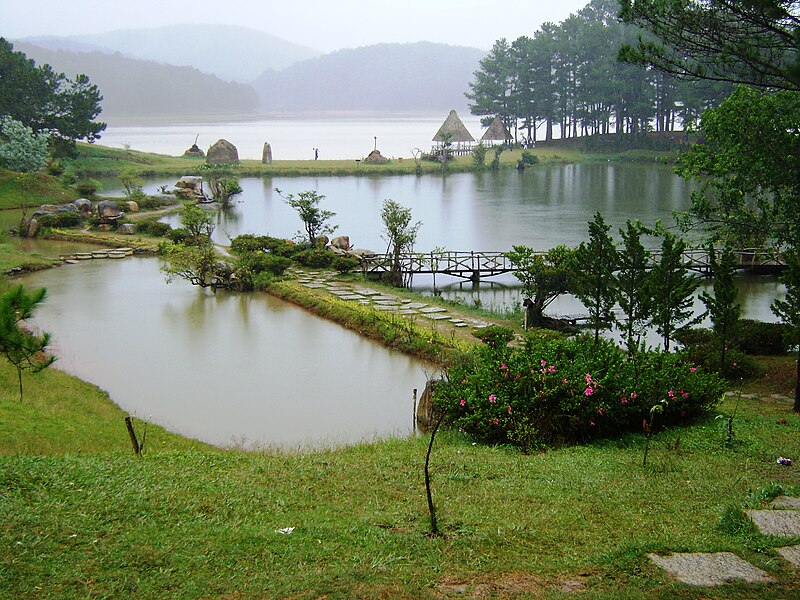Dalat and Lam Dong Overview
Being the capital city of Lam Dong Province,Dalat has its own poetic and romantic charm at 1,500 meters above sea level and 18ºC everage temperature. Many of most famous and beautiful lakes and waterfalls in Vietnam can be found here together with hills, pine-tree forests, vegetable gardens and flowers. Dalat has more than 300 French villas scattered on the hills giving it the beauty you can find nowhere.
Unfortunately, Dalat's central feature, the Xuan Huong lake, has been completely drained by the authorities for maintenance. From early 2010 until mid to late 2011, the jewel in the crown of Dalat is now just an empty dust bowl, with trucks full of dirt running through the roads of the city taking the fertile soil out to the countryside.
Located in the Central Highlands region, Lam Dong is a mountainous province, and 70% of its area is covered in forest.
North: Dak Lak and Dak Nong provinces
South-East: Khanh Hoa, Ninh Thuan and Binh Thuan provinces
West: Binh Phuoc and Dong Nai provinces
The North of Lam Dong is high mountains, the Lang Biang plateau, with summits of altitudes between 1,300m – above 2,000m such as Bidoup (2,287m), Lang Biang (2,167m). The East and the West are mountains with modest altitudes (500m – 1,000m). The South is the transition from the Di Linh – Bao Loc plateau to the semi-flat country.

A panorama image of Đà Lạt city centre seen from Xuan Huong Lake
Architecture
The architecture of Đà Lạt is dominated by the style of the French colonial period. Đà Lạt Railway Station , built in 1938, was designed in the Art Deco architectural style by French architects Moncet and Reveron, although it incorporates the high, pointed roofs characteristic of the Cao Nguyen communal buildings of Vietnam's Central Highlands.The three roofs, said to represent the three peaks of Đà Lạt's iconic Lang Biang mountain, are also reminiscent of Normandy's Trouville-Deauville Station .The station's unique design—with its roofs, arching ceiling, and coloured glass windows—earned it recognition as a national historical monument in 2001. The Dominion of Mary ( French : Domaine de Marie ) Church and Convent , home to Roman Catholic nuns of the Mission of Charity, were built in 1938 with a similar pointed-roof style.
Of particular note is the unconventional architecture of the Hằng Nga guesthouse , popularly known as the “Crazy House”.Described as a “fairy tale house”, its overall design resembles a giant banyan tree, incorporating sculptured design elements representing natural forms such as animals, mushrooms, spider webs and caves.Its architecture, consisting of complex, organic, non-rectilinear shapes, has been described as expressionist .Its creator, Vietnamese architect Dang Viet Nga (also known as Hằng Nga), who holds a PhD in architecture from Moscow State University , has acknowledged the inspiration of Catalan Spanish architect Antoni Gaudí in the building's design.Visitors have variously drawn parallels between the guesthouse and the works of artists such as Salvador Dalí and Walt Disney . Since its opening in 1990, the building has gained recognition for its unique architecture, having been highlighted in numerous guidebooks and listed as one of the world's ten most “bizarre” buildings in the Chinese People's Daily
 |
| Hang Nga guesthouse |
There are many the great point that you can not come to visit the Dalat
Golden Valley
Golden Valley Springs is famous tourist destination with flower gardens and pine forests.Suoi Vang Lake is the largest freshwater lake in Da Lat, providing water for the city over the spillway water supply company Dalat.
 |
| Golden Valley in morning fog
Da Lat should ever dream dreams and poetry through the cold highlands night, morning fog and strip pine forests around the cities. Attractions Temples and meditation Library
Trúc Lâm Zen Monastery
Truc Lam Zen Monastery is the largest in Vietnam, inaugurated in 1994, is one of the largest Buddhist building after 1975. Wat is located next to Tuyen Lam lake on a large land area 25 ha. Truc Lam is currently connected to the city center of Da Lat (Robin Hill) with the cable system, transporting visitors back to Zen fromTuyen Lam.From 2005, the government of Lam Dong to build a major tourist area, attracting approximately about 30 investors.
Trúc Lâm Zen Monastery

Tuyền Lâm Lake
Linh Phuoc Pagoda
Linh Phuoc Pagoda is also called Wat Chai Ve because the airport is 49 m long dragon made of 12,000 bottle, porcelain. Wat is a unique architectural mosaic connoisseurs of Dalat. Pagoda is located at Camp Mat, a town center 10 km to the east.
Linh Son Pagoda
Linh Son Pagoda was built from 1938 to 1940 due to the contribution of Buddhists, especially Mr. Vo Dinh and Nguyen Van Tien Dung, who received most of the bidding architecture period.
Thien Vuong Co Sat Pagoda
Thien Vuong Co Sat Pagoda was built starting in 1958, the center of Da Lat is about 5 km, is located on a Hill. The main temple has three power 4 m high Buddha visiting from Hong Kong, behind the temple, on the Hill Thich Ca Buddha statue is 20 meters high Radio Chua also called Chua Tau, the system Hue Nghiem Buddhist sects in China. Linh Phong Pagoda
Linh Phong Pagoda is located in Hoang Hoa Tham, built in 1944. In temples, there should nun temple also known as unused Women.
(continue....) |










